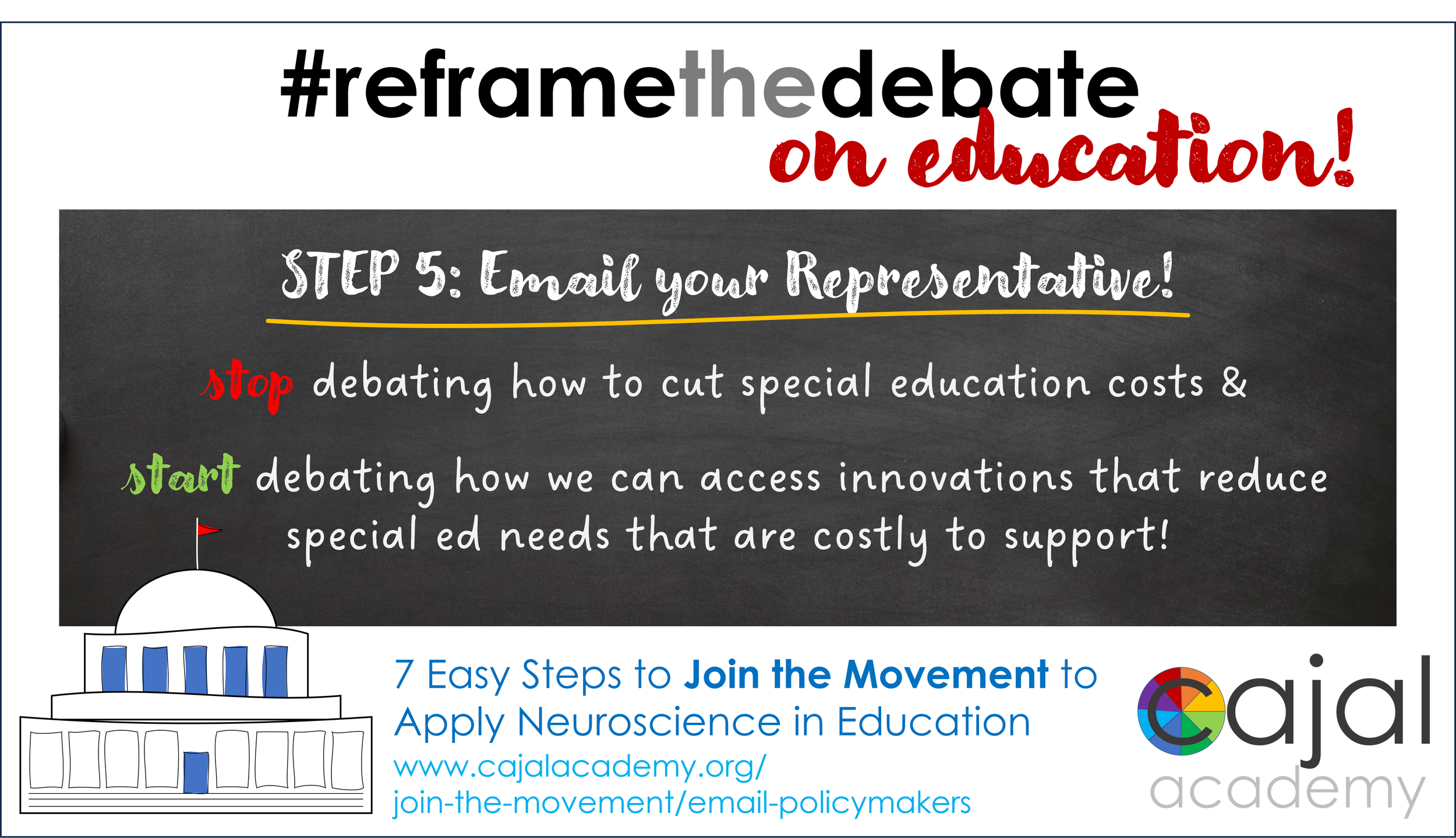What’s Involved
Contact Your State Representative
Time Commitment: 8 minutes
What You're Asking For:
✅ Recognize Connecticut has homegrown innovation worth supporting
✅ Clarify that districts CAN partner with innovative programs under 10-76g
✅ Consider state pilot funding for proven innovation
✅ Balance "state-approved blueprint" requirements with space for innovation
You're NOT:
❌ Asking to eliminate state approval process or in-district programs
❌ Criticizing special education in general, or pitting student profiles against one another
❌ Making partisan political arguments
Tell state education policymakers that you want neuroscience-based education for Connecticut kids!
Tell your district about innovation they can access under existing law today that reduces long-term costs, while contributing to research that can catapult your district forward in the future!
Email your representatives
Request that Connecticut invest in innovation today—here’s why this matters for children, for families and for over-burdened taxpayers as well
The heated debate in May, 2025 and legislation that followed put a laser focus on special education costs and proscribed a short-sighted solution: make it even more onerous for families to secure reimbursements for unilateral outplacements to schools that aren’t on the “state approved” list, and provide incentives for districts to create their own in-house solutions to replace those that are.
But that legislation also preserved the exception that school districts can contract on the same terms and apply the same reimbursement funds for schools that are not state approved IF they reduce the costs of meeting that child’s needs relative to the public arrangement.
That’s already in the legislation—but public school districts aren’t even aware of it, or don’t understand how our innovative special education approach can reduce educational costs dramatically, typically after 1-2 years in the program.
Here’s what our policymakers may not know—and need to:
Our communities don’t need to continue the false choice between reducing costs and improving our schools—in fact, we can’t afford to. Neuroscience has moved forward dramatically since the traditional special education blueprint was put in place—and shows that the human brain is constantly rewiring itself through neuroplasticity. We’ve proven over the last 6 years that this can be used to reduce or even remove disabilities, through a new blueprint that starts with the neuropsychology of how children learn, socialize and grow. This catapults them as much as 6 grade levels in 6 months time academically, while also improving social-emotional and behavioral outcomes, cutting off or even reversing the therapeutic escalations pathway that is bankrupting our towns. This reduces educational costs for the remaining K-12 years by as much as $100,000 per child per year in specialists time and therapeutic placements avoided, for a savings that could reach $1-2 million per child.
Legislators ensured that existing CT law (10-76g) permits partnerships with programs that reduce costs relative to the publicly-available arrangement—even without state approval—with the same cost reimbursement mechanisms. Yet school districts are focused only on the part of the statute that speaks to state-approved schools, and aren’t evaluating whether a given non-approved program might fit within the second half of the authorizing provision. Parents are simply told “we won’t support it”—even where there’s no program on the state approved list that can provide an appropriate education (FAPE) for the child (as required by the IDEA), without even considering how it might change the economics of meeting the child’s needs going forward. We need legislators’ assistance to remind districts that this is an inappropriately limited interpretation of their act; rewriting this legislation is outside local school districts’ purview.
The regulations proscribing what’s required to become a state approved school presume the same accommodations-based special education blueprint that we use in the public schools. This misses the opportunity to actually reduce or remove student disabilities, reducing costs while transforming lives. This stifles innovation in the state of Connecticut, by categorically denying funds to programs that are developing new blueprints that keep up with new science and can move all our schools forward. Other states don’t do that. That risks our state falling behind where we need it most: innovation that can lead to new solutions like ours that improve student outcomes and reduce costs.
There are whole cohorts of kids—starting with ones who have twice exceptional profiles—who are not just under-served but hurt by mainstream educational approaches. Something like 90% of our applicants report prior school-based trauma. When their children’s efforts to collaborate on an outplacement to Cajal (the only outplacement option tailored to these children’s needs) are shot down, they are devastated—and many give up and homeschool not because they want to but because they don’t feel they can keep forcing their child to go some place where they repeatedly get hurt.
By limiting access to innovative schools to only the wealthiest in our community, who can afford to pay for them on their own, we further increase the economic divide that’s already dividing our region and disproportionately hurting children from minority communities. In the case of Cajal Academy, because we actually remove disabilities, that means our wealthiest children have the opportunity to get onto a course towards a future defined by their strengths as our co-founder did for her own child, our first graduate. Meanwhile, the rest of our children are condemned to stay on course towards a future defined by their challenges. That further broadens inequities at a profound level.
It’s part of Cajal’s non-profit charter to publish and disseminate these break-throughs. It’s in our non-profit charter, and our organization’s DNA, to do so. We developed these protocols working with cohorts of 5-11 students at a time, all of whom have very high reasoning or creative abilities and asynchronous profiles. We have taken a 20,000 square foot space in the center of SONO and put the pieces in place to scale up to 20 and then 50 kids: a size (and diversity) of cohort that will allow us to publish these findings in peer-reviewed literature, begin to test their application with other cohorts of kids, and deliver evidence-based protocols that could be imported into Connecticut public schools so that all our children have access to this extraordinary, neuroscience-based educational approach. In the process, Connecticut can secure its reputation as the absolute leader in neuroscience-based education. Without that investment, our scaling will be significantly slower, which means that Connecticut may lose the edge to other states that have more innovation-friendly policies.
🌟 Why Your Voice Matters
Legislators hear from lobbyists, special interest groups, and bureaucrats all the time. It isn’t very often that they hear from real constituents sharing not just problems but potential solutions.
Your email will help them see a new way forward:
the opportunity to invest in homegrown local innovation that could secure our state’s leadership position in the country and beyond
the chance to spare vulnerable children undue (and legally questionable) trauma by opening up alternatives to a blueprint that for them, simply doesn’t work
the importance to their constituents of investing in innovation that can help us improve both education and fiscal responsibility
the bipartisan reality that constituents support for balancing oversight with innovation
Every letter shifts what's politically possible.
Here’s how to do this in just 5 minutes!
Click on the ‘plus’ sign beside each title to get the details!
-
✏️ PERSONALIZATION TIPS:
Make it stronger by adding:
Local angle:
"As a [Town] resident, I'm proud Connecticut has this innovation..."
"Our town's special ed costs have increased [X%]—we need approaches that actually reduce costs..."
Personal connection:
"As a parent of a child with learning differences, I wish this existed when my child was young..."
"As a taxpayer, I'm frustrated watching costs spiral while outcomes don't improve..."
Specific to your rep:
"Given your leadership on [education/fiscal/innovation] issues, I thought you'd be interested..."
"You've supported [X initiative]—this aligns with that commitment..."
Keep it:
Respectful and professional
Focused on Connecticut pride
Fiscally responsible framing
Specific about what you're asking
-
Make it stronger by adding:
Local angle:
"As a [Town] resident, I'm proud Connecticut has this innovation..."
"Our town's special ed costs have increased [X%]—we need approaches that actually reduce costs..."
Personal connection:
"As a parent of a child with learning differences, I wish this existed when my child was young..."
"As a taxpayer, I'm frustrated watching costs spiral while outcomes don't improve..."
Specific to your rep:
"Given your leadership on [education/fiscal/innovation] issues, I thought you'd be interested..."
"You've supported [X initiative]—this aligns with that commitment..."
Keep it:
Respectful and professional
Focused on Connecticut pride
Fiscally responsible framing
Specific about what you're asking
-
Click here to find your state representative
Send to:
Your state representative (House)
Your state senator (Senate)
Bonus impact: CC the Education Committee chairs
Format:
Email: Usually [firstname.lastname]@cga.ct.gov
Postal mail: State Capitol, Hartford, CT 06106
Both: Maximum impact!
-
We're tracking which legislators are hearing about this—helps us understand where to focus advocacy efforts.
Plus, if your representative responds positively, we can help provide additional information.
-
Best case: Office responds, schedules meeting or visit
Likely case: Form letter acknowledging receipt
Possible: Staff reaches out for more information
Sometimes: No response (they're overwhelmed)
Don't be discouraged! Your letter is read and logged. Multiple constituents writing = increased attention.
-
Q: I don't know much about education policy. Should I still write? A: Yes! You're a constituent—your voice matters. The template gives you everything you need.
Q: Will this be seen as too political? A: The letter is carefully framed as fiscally responsible innovation—appeals across political spectrum.
Q: What if my representative is on Education Committee? A: Even better! They're especially important to reach. Consider calling their office too.
Q: Should I mention my political party? A: Not necessary. This transcends partisan politics—it's about innovation, fiscal responsibility, and children.
Q: Can I send the same letter to House and Senate? A: Yes, though personalizing slightly for each is even better.
Q: What if I get a form letter response? A: That's normal. The important thing is your voice was heard and logged.
-
Already wrote your state rep? Amplify your impact:
Follow up in 2 weeks:
Call their district office
Ask if they received your letter
Request a meeting or briefing
Attend events:
Town halls with your representative
Coffee hours / constituent meetings
Bring this up in person
Coordinate:
Ask neighbors to write too
Organize letter-writing event
Collect signatures on petition
Share:
Post on social media that you wrote
Encourage others to do same
Tag your representative (respectfully)
Done! What’s next?
Thank You! Here are some more quick and easy actions you can take to support our movement to #ReframeTheDebate on Education!


